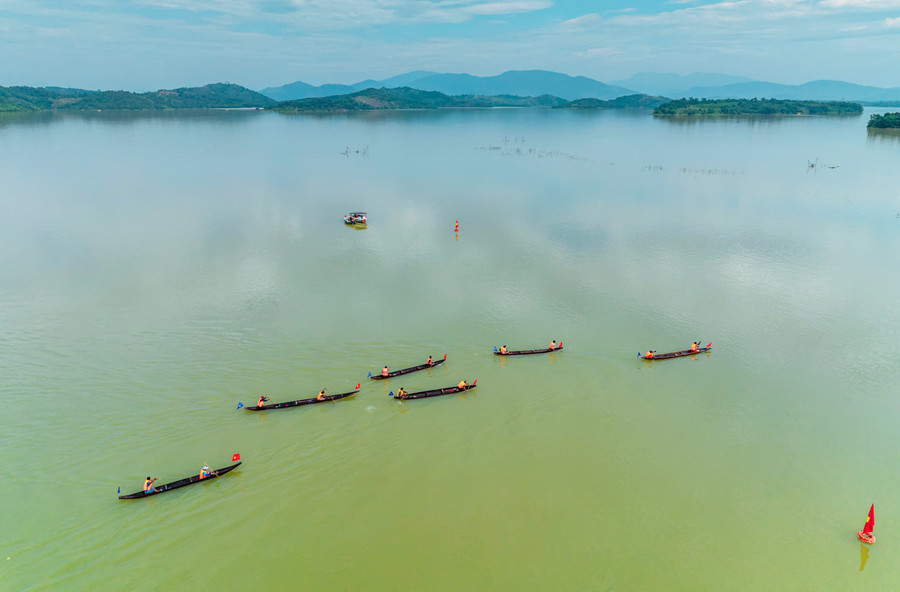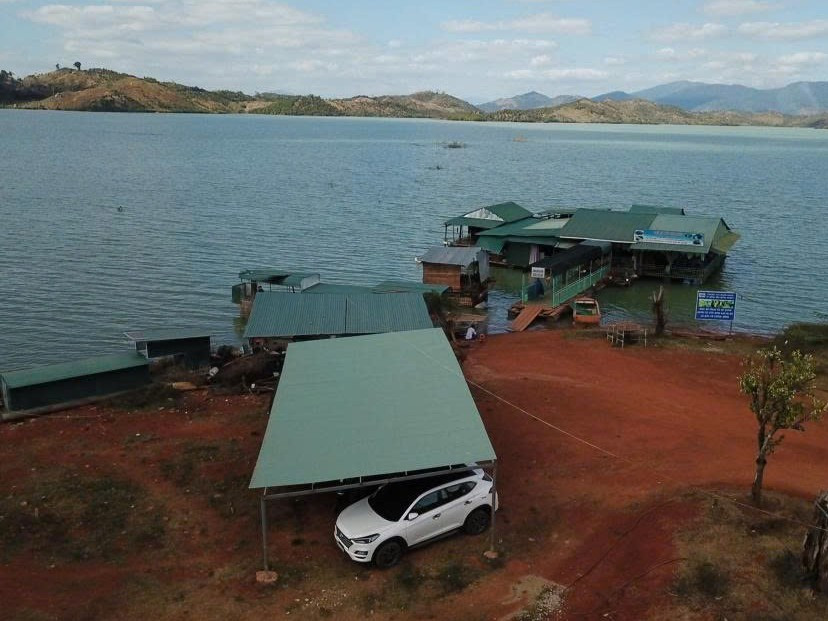The Po Ko River originates from the Ngoc Linh Mountain area (Quang Ngai province), passes through the old forest, flows along the vast coffee and rubber hillsides in the two provinces of Gia Lai and Quang Ngai, then flows into Cambodia, and joins the Mekong River. Particularly from the confluence with the Dak Bla River towards Ia Krai commune, in addition to the name Po Ko, the river also has another name, Se San.
Memory Stream
Winding like a green silk strip between heaven and earth, the Po Ko River flows through the territory of three communes: Ia Krai, Ia O (Gia Lai province), Ia Toi ( Quang Ngai province), carrying alluvium, fish, shrimp and memories of many generations of people settling along the river.
For the people of Ia Krai commune, this place is also a source of pride when mentioning the contributions of previous generations in the resistance war against the US. To this day, many people still remember the story of Hero A Sanh (real name Puih San) and the local people rowing dugout canoes carrying food, medicine and soldiers across the Po Ko River to the battlefield to fight the invading enemy.
Looking towards the Po Ko River, Mr. Ro Lan Penh (residing in Nu village, Ia Krai commune) emotionally told about a fierce war period and the sacred meaning that filled the minds of the people here.
“During the years when the whole country was fighting the Americans, the villagers enthusiastically participated in the revolution, some hid cadres, some rowed boats to transport food, ammunition and soldiers across the Po Ko River. The most typical example was the People's Armed Forces Hero A Sanh. In 1963, I volunteered to join the guerrillas to fight the Americans, joining the special transport force to transport food and soldiers day and night across the Po Ko River. There was a time when I had to row for 10 consecutive days and nights, bringing an entire division across the river. Currently, the A Sanh ferry at the end of the village has been recognized as a provincial historical relic. We are very proud of this,” recalled old man Penh.

According to veteran Ro Lan Kai, former Party Secretary of Ia Krai commune, around 1970, he used motorboats instead of dugout canoes to transport food and troops. In a 200-meter wide river section, motorboats would be more maneuverable and move faster to avoid enemy ambushes.
“We often hung an oil lamp in front of the boat, and there was also one at the ferry on the other side. Based on that weak light, we could determine the exact location. Once, I was transporting a shipment of about 3 tons of food and weapons across the river, but the engine had a problem. The boat just drifted freely. Everyone was very worried because they were afraid of revealing the secret. Luckily, the river route was on Cambodian land, the terrain was relatively flat, not as many rapids as the section flowing through Gia Lai. The boat drifted for a while, and I was struggling to fix it when the engine started. I was so happy that I just let the boat go upstream to find the ferry in the pitch-dark night,” Mr. Ro Lan Kai recalled.
For the old man Ro Cham Hmong, the decision to move Nu village to settle along the Po Ko river opened a turning point in the history of the villagers' struggle against foreign invaders.
Old Hmong confided: “Previously, the village was on the other side of the Po Ko River, now under the administrative boundary of Quang Ngai province. When the enemy continuously rained down bombs and bullets, destroying the fields, the villagers decided to move to this side. The location of the village was the promontory where the Ia Plú stream flows into the Po Ko River. From the favorable location and with their strong patriotism, the villagers actively participated in the guerrillas, transported food, and soldiers crossed the river to fight the American invaders.”
Po Ko today
Po Ko is still peaceful and full of life. The river water irrigates thousands of hectares of coffee, pepper, cashew, and rubber along both sides of the river in Ia Krai, Ia O communes and in Ia Toi commune on the other bank. The lush green fields and fruit-laden orchards are proof of the favor of this legendary river.
Old Hmong recalled: "During the war years, backward farming methods caused the people of Nu village to be trapped in poverty. When they moved from Quang Ngai to Gia Lai to establish the village, every house was tiny, with walls made of bamboo and roofs thatched with forest leaves. Upland rice was scarce in good years and abundant in bad years, so people had to go into the forest to find food to fight hunger."
Nowadays, Nu villagers have started to grow cashew, rubber, and coffee. Income from industrial crops has helped people have a more stable life. Many households have high income from agricultural production. For example, Puih Luih's family has an income of 250-300 million VND/year. 115 households in the village all have houses, many of which are large and beautiful, with a construction cost of 200-300 million VND.

Downstream along the Po Ko River, on the riverbank, Dang village (Ia O commune) is transforming itself to face new opportunities. The village has over 200 households with over 1,200 people, most of whom are Jrai people. The village's traffic infrastructure and lighting system have been systematically invested in. The village has many new houses built on old land, with motorbikes, televisions and other audio-visual equipment in the houses.
Ms. Ro Mah Hlien confided: "Thanks to hard work, the villagers have a more prosperous life than before. In addition to growing cashew and coffee, the villagers also work as workers for rubber companies located in the area."
When Ia Grai district (old) chose the alluvial land next to the village as the venue for the A Sanh Cup Boat Racing Festival on the Po Ko River, each year, the villagers had an additional source of income from selling local specialties to tourists.
"Many households with good economic conditions open floating restaurants next to the alluvial land to do culinary business, take tourists to see the river and then visit the fishing village in Ia Toi commune or raise fish in cages in the river bed," Ms. Hlien added.
Mr. Nguyen Thanh Phuong - Chairman of Ia Krai Commune People's Committee - said: Po Ko River not only provides water for agricultural production but also has a rich source of aquatic products, helping people increase their income.
With its wild beauty and historical and cultural values, the commune is aiming to develop riverside community tourism, associated with history, ecology and indigenous culture, creating new livelihoods for people.
The commune has also surveyed tourist sites and called for investors to develop local tourism. This has been implemented since before the merger of old communes into the new Ia Krai commune.
“In the future, we will work with neighboring communes along the Po Ko River to coordinate in developing a tourism development plan,” Mr. Phuong added.
The scenery of Po Ko changes with each vivid moment of the day. Early in the morning, mist lightly covers the water surface, and the A Sanh ferry appears like a magical ink painting.
On the river at A Sanh ferry, besides a few dugout canoes rowing and fishing on the river, 12 iron ferries still cross the Po Ko river to transport people back and forth on both sides of the river to make a living. Each ferry trip departing from A Sanh ferry is not only a fun journey connecting the two banks but also relives the heroic memories of the legendary river.
Source: https://baogialai.com.vn/suc-song-moi-ben-dong-po-ko-post565377.html



![[Photo] Lao President Thongloun Sisoulith and President of the Cambodian People's Party and President of the Cambodian Senate Hun Sen visit the 95th Anniversary Exhibition of the Party Flag Lighting the Way](https://vphoto.vietnam.vn/thumb/1200x675/vietnam/resource/IMAGE/2025/9/2/3c1a640aa3c3495db1654d937d1471c8)
![[Photo] National Assembly Chairman Tran Thanh Man receives First Vice Chairman of the Federation Council of Russia](https://vphoto.vietnam.vn/thumb/1200x675/vietnam/resource/IMAGE/2025/9/2/3aaff46372704918b3567b980220272a)


![[Photo] National Assembly Chairman Tran Thanh Man meets with First Secretary and President of Cuba Miguel Diaz-Canel Bermudez](https://vphoto.vietnam.vn/thumb/1200x675/vietnam/resource/IMAGE/2025/9/2/c6a0120a426e415b897096f1112fac5a)






























































































Comment (0)